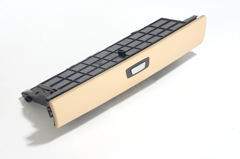Jan 26 2010
DirectSkinning technology is a new production process that improves cost efficiency in the production of injection molded parts in a single step. It has now been used for the first time with an aliphatic polyurethane material in the series production of vehicle interior parts.
 Thanks to the light-stable 2-component polyurethane system Bayflex® LS, the decorative panel can also be produced in light colors. The part is manufactured by the DirectSkinning process.
Thanks to the light-stable 2-component polyurethane system Bayflex® LS, the decorative panel can also be produced in light colors. The part is manufactured by the DirectSkinning process.
As part of a technology project devoted to the DirectSkinning process, fischer automotive systems GmbH and Bayer MaterialScience AG have been successful in jointly developing a decorative panel that is now manufactured in series production. The component seals off a kinematic drawer located on the dashboard of the BMW 5 Gran Turismo series directly above the central console.
"Our joint project demonstrates that DirectSkinning is ready for series production and can be used to manufacture injection moldings with high-quality, colored decorative polyurethane surfaces for vehicle interiors," explains Dr. Michael Baumeister, head of Production and Logistics at the Horb, Germany plant of fischer automotive systems.
The approximately 1.4 millimeter thick covering for the panel is based on the polyurethane system Bayflex LS (LS = Light Stable) from BaySystems. BaySystems is the global umbrella brand for the polyurethane systems operations of Bayer MaterialScience. The system used here was specially developed for the DirectSkinning process. The panel is produced in five colors, including ivory white, light beige and gray. "Our polyurethane systems meet the growing demand for light colors in vehicle interiors as they deliver lasting UV resistance and color fastness. They also give the surfaces a high level of scratch and abrasion resistance," says Gregor Murlowski, a polyurethanes expert at Bayer MaterialScience. The panel's thermoplastic substrate consists of the heat- and impact-resistant polycarbonate acrylonitrile-butadiene-styrene (PC/ABS) blend Bayblend T85, another material from the Leverkusen-based company.
Short cycle times, lower investment, simpler logistics
"DirectSkinning technology combines injection molding of thermoplastics with the reaction injection molding (RIM) process for polyurethane processing. The coated component is produced directly on the injection-molding machine in a single mold (multiple molds are also possible) in a process that is comparable to multi-component injection molding. After manufacturing of the thermoplastic substrate, the polyurethane system is injected into the closed mold via a polyurethane mixing head and the thermoplastic surface is thus coated. "When a rotary table or swivel platen mold is used, the two production steps can be performed in parallel, for example, thus ensuring short cycle times and high productivity," explains Andreas Bürkle, who is in charge of the DirectSkinning project at fischer automotive.
Parts produced in this way require very little secondary finishing. The thickness and color of the polyurethane layer can be varied over a broad range. As the component is produced in a single mold, DirectSkinning does not require a separate coating system, in contrast to traditional methods. "The investment and space needed for the machines are reduced accordingly. Transportation and interim storage of the fresh injection moldings become a thing of the past, simplifying logistical processes and minimizing the risk of contamination and damage," says Rainer Protte, who is responsible for the development of special injection molding processes at Bayer MaterialScience.
Hot-light aging tests passed
The light stability of the decorative panel's polyurethane surfaces has been thoroughly tested. This included heat aging, hot-light aging, climatic change and solar simulation testing. Testing showed that virtually no surface defects, discoloring, yellowing or hardness fluctuations occur over the service life of the component, thus satisfying automakers' stringent requirements concerning the yellowing stability of plastic surfaces in vehicle interiors. It was also possible to precisely map the mold, whose surface has a leather-like grain, adapt the polyurethane surface exactly to the color specifications and match its optical effect precisely to neighboring surfaces made from other materials (color matching). This successful series development was preceded by extensive joint work. For instance, the feasibility of the DirectSkinning process was tested on a prototype component from a series application - decorative trim for a cup holder.